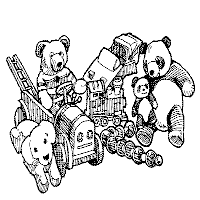| Washing
and Disinfecting Toys

- Infants
and toddlers should not share toys. Toys that children (particularly
infants and toddlers) put in their mouths should be washed and disinfected
between uses by individual children. Toys for infants and toddlers should
be chosen with this in mind. If you can't wash a toy, it probably is
not appropriate for an infant or toddler.
- When an
infant or toddler finishes playing with a toy, you should retrieve it
from the play area and put it in a bin reserved for dirty toys. This
bin should be out of reach of the children. Toys can be washed at a
later, more convenient time, and then transferred to a bin for clean
toys and safely reused by other children.
- To wash
and disinfect a hard plastic toy:
- Scrub
the toy in warm, soapy water. Use a brush to reach into the crevices.
- Rinse
the toy in clean water.
- Immerse
the toy in a mild bleach solution (see above) and allow it to soak
in the solution for 10-20 minutes.
- Remove
the toy from the bleach solution and rinse well in cool water.
- Air
dry.
- Hard plastic
toys that are washed in a dishwasher or cloth toys washed in the hot
water cycle of a washing machine do not need to be additionally disinfected.
- Children
in diapers should only have washable toys. Each group of children should
have its own toys. Toys should not be shared with other groups.
- Stuffed
toys used by only a single child should be cleaned in a washing machine
every week, or more frequently if heavily soiled.
- Toys and
equipment used by older children and not put into their mouths should
be cleaned at least weekly and when obviously soiled. A soap and water
wash followed by clear water rinsing and air drying should be adequate.
No disinfection is required. (These types of toys and equipment include
blocks, dolls, tricycles, trucks, and other similar toys.)
- Do not
use wading pools, especially for children in diapers. (See “Outdoor
Playground Areas...” for further discussion.)
- Water
play tables can spread germs. To prevent this:
- Disinfect
the table with chlorine bleach solution before filling it with water.
- Disinfect
all toys to be used in the table with chlorine bleach solution.
Avoid using sponge toys. They can trap bacteria and are difficult
to clean.
- Have
all children wash their hands before and after playing in the water
table.
- Do
not allow children with open sores or wounds to play in the water
table.
- Carefully
supervise the children to make sure they don't drink the water.
- Discard
water after play is over.
|